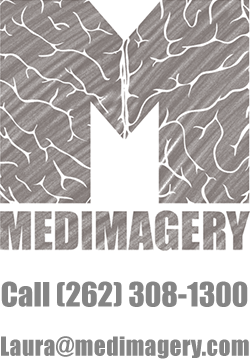
What is a Medical Illustrator? About the Career of Medical Illustration
About the Career
What do Medical Illustrators Do?
Written by Laura Maaske, MSc.BMC, Medical Illustrator & Medical Animator
While it comes as a surprise to medical illustrators, it is very common when I mention the work I do to be asked, “So, what is a medical illustrator, exactly?”
What is a Medical Illustrator?
Medical illustration, or biomedical visualization, is the practice of biomedical communication, specializing in visual representations of aspects of medicine and science. Common forms of expression include digital art, physical modeling, 2d animation, 3d animation and app development, among others. Biomedical illustrators are able to utilize their strong drawing skills together with their background biology, botany, zoology and other sciences. Medical illustrators draw a wide range of subjects from surgery to human and veterinary anatomy; animal life and plant life; chemical, molecular, and atomic structuress, and geologic and planetary formations.
While “medical illustrator” and “medical illustration” are the most commonly used terms to describe the nature of the work, there are many other terms which have been used to describe the field, including but not limited to, “biomedical illustration”, “biological illustration”, “medical art”, and “biomedical visualization”.
Medical visualizers work in various fields from textbook illustration, medical publishing, medical legal exhibit preparation, pharmaceutical illustration, medical training materials, advertising illustration, health promotion illustration or animation, and surgical illustration. Medical illustrators typically have earned an undergraduate degree in some field of art or science, and subsequently earn a graduate degree specializing further in the field of biomedical visualization. The graduate work consists of medical school coursework or its equivalent, as well as hands-on instruction from professors and colleagues in the field or in adjacent fields of study. Frequently summers are spent enrolled in internships or in research study for the Master’s degree.
Biimedical illustrations are used for various media; conference slide presentations, pharmaceutical animations, medical and scientific publications, exhibits, web, print materials for textbooks and journals.
SOFTWARE REQUIREMENTS:
The Primary Organization Representing Medical Illustrators in the U.S.
The Association of Medical Illustrators, AMI, was instituted to maintain the standards for training in medical illustration and to provide ethical guidelines for practice:
AMI Headquarters
1819 Peachtree Street, N.E., Suite 620
Atlanta, Georgia 30309 U.S.A.
(404) 350-7900, Fax: (404) 351-3348
The AMI holds an annual conference. Amanda Montanez wrote a great reviw of it.
Other Organizations for Medical Illustrators
Institute of Medical Illustration UK
Medical Artist’s Association of Great Britain (MAA): http://www.maa.org.uk/
Association Européenne des Illustrateurs Médicaux et Scientifiques (AEIMS): http://www.aeims.eu/
A few links to begin exploring
- Association of Medical Illustrators Question and Answer Page .
- The question about how e-books can be making use of medical illustrations dynamically.
- What it’s like as a medical illustrator
- Med Monthly’s article about medical illustration
- A personal perspective
- Wikipedia’s article on medical illustration
- Leonardo DaVinci’s Anatomical Drawings
- Wikipedia’s Frank Netter article
- Wikipedia’s Max Brodel article
- Wikipedia’s Andreas Vesalius article
- Eila Hopper Ross article
Read more about the career of medical illustration here.
Graduate Programs
Annie Campbell has created a beautiful video about the medical illustration programs:
Many illustrators go on to earn Master’s degrees in biomedical visualization or biomedical communication. There are programs in North America that provide Master’s degrees in medical illustration. The programs listed below are accredited by the AMI.
-
- University of Toronto
Division of Biomedical Communications Located on two campuses at the University of Toronto:U of T Mississauga Campus
Room 308, Terrence Donnelly Health Sciences Complex
3359 Mississauga Road North
Mississauga, ON Canada L5L 1C6
Phone: 905-569-4849
Fax: 905-569-4847
U of T St. George Campus
Room 75, Fitzgerald Building
150 College Street
Toronto ON Canada M5S 3E2
Phone: 416-978-2659 Email
- University of Toronto
-
- Dept. of Medical Illustration
Georgia Health Sciences University
1120 15th Street, CJ1101 Augusta, GA 30912-0300
Fax: 706-721-7855
Email
- Dept. of Medical Illustration
-
- University of Chicago
Department of Biomedical Visualization
College of Associated Health Professions
University of Illinois at Chicago
1919 W. Taylor Street, Room 213, M/C 527
Chicago, Illinois 60612
Tel: (312) 996-4975
Fax: (312) 996-8342
(312) 996-7337 Email
- University of Chicago
-
- Medical and Biological Illustration Graduate Program
Department of Art as Applied to Medicine
The Johns Hopkins School of Medicine
1830 E. Monument Street, Suite 7000
Baltimore, Maryland 21205-2100
Tel: (410) 955-3213
Fax: (410) 955-1085 Email
- Medical and Biological Illustration Graduate Program
-
- The University of Texas-Southwestern Medical School-DallasBiomedical Communications Graduate Program
Dept. of Health Care Sciences
The University of Texas
Southwestern Medical Center at Dallas
5323 Hines Blvd.
Dallas, Texas 75235-8881
Tel: (214) 648-4699
Fax: (214) 648-5353 Email
- The University of Texas-Southwestern Medical School-DallasBiomedical Communications Graduate Program
ENGLAND
Art in Science at Liverpool John Moores University, Liverpool, England, UK https://www.ljmu.ac.uk/study/courses/…
SCOTLAND
Medical Art at University of Dundee, Dundee, Scotland, UK https://www.dundee.ac.uk/study/pg/med…
Medical Visualization and Human Anatomy at Glasgow School of Art, Glasgow, Scotland, UK http://www.gsa.ac.uk/study/graduate-d…
THE NETHERLANDS
Master in Scientific Illustration at Maastricht Academy of Fine Arts, Maastricht, The Netherlands https://www.zuyd.nl/scientific-illust…
SWITZERLAND
Scientific Visualization at Zurich University of the Arts, Zurich, Switzerland https://www.zhdk.ch/
FRANCE
Design d’Illustration Scientifique at École Supérieure Estienne des Arts Graphiques, Paris, France http://www.ecole-estienne.paris/forma…
What is a typical Medical Illustration Job like?
Upon graduation, Medical illustrators have the option to freelance, to work for an organization, to work at a university, or to seek employment in companies specializing in animation or illustration. A typical position might require a list of skills such as these:
DUTIES AND RESPONSIBILITIES:
ACADEMIC REQUIREMENTS:
For More Information…
For artistic tips on how to draw a good medical illustration, please visit my tips page.
September 25, 2018
_________________________________
Laura Maaske, MSc.BMC.
Biomedical Communicator
Medical Illustrator
Medical Animator
Health App Designer




2 Comments